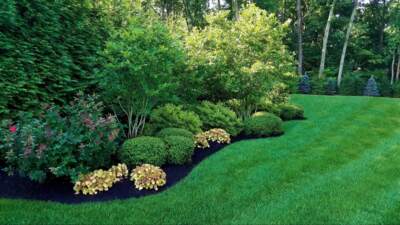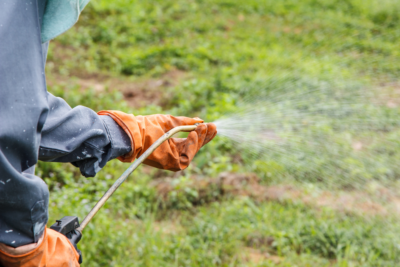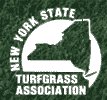 Weeds. Even the name sounds ugly. And if allowed to spread, weeds get even uglier, competing with your lawn for water, sunlight and important nutrients. They’ll happily take over your pretty green and healthy lawn if you let them. Don’t.
Weeds. Even the name sounds ugly. And if allowed to spread, weeds get even uglier, competing with your lawn for water, sunlight and important nutrients. They’ll happily take over your pretty green and healthy lawn if you let them. Don’t.
That’s where a weed killer comes in. To kill weeds, timing is everything. Let’s take a closer look at when to apply herbicide to your lawn as well as how it actually works.
Post-emergent herbicides vs Pre-emergent herbicides
Post-emergent herbicides are applied to the soil after plants have emerged from the ground. These types of weed killers work by applying it to existing weeds, killing them and preventing any further growth. They work by penetrating into the plant’s tissues, where they block its ability to photosynthesize and eventually end the weed’s life cycle. Post-emergent weed killers are often used to control hard-to-kill weeds, such as annuals or perennials. You can also apply post-emergent herbicides in areas that have been overrun with noxious weeds.
Pre-emergent herbicides, on the other hand, are applied before plants have emerged from the ground. These types of herbicides form a barrier around the seeds or plants, preventing weeds from being able to germinate and grow. Pre-emergent herbicides are often applied before planting to prevent any weeds from taking over the area. They can also be used after planting to reduce the risk of weed growth.
Applying pre-emergent herbicides provides longer-lasting control compared to applying post-emergent herbicides. They are a popular choice amongst our clients who want a healthy lawn and an eye-catching landscape. Below, we discuss pre-emergent herbicide and post-emergent herbicide application in more depth.
How Does Pre-Emergent Herbicide For Lawns Work?
These weed killers target weed seeds before they germinate, so pesky weeds don’t even have a chance to sprout. The weed is killed when it begins to sprout from the seed and hits the herbicide barrier.
The key word here is “pre-emergent.” That means it’s applied to the lawn before grassy weeds can grow. If you have a history of annual weeds sprouting in your lawn, this kind of weed prevention is for you.
When To Apply Pre-Emergent Herbicide To Lawns
 Applying weed killers can be tricky. There’s a fairly small window of opportunity here. A calendar is actually less helpful than a thermometer, because this is a matter of ground temperature.
Applying weed killers can be tricky. There’s a fairly small window of opportunity here. A calendar is actually less helpful than a thermometer, because this is a matter of ground temperature.
Weed seeds germinate at varying temperatures. Crabgrass — one of the big problem weeds in New York and Connecticut lawns — germinates when soil temperatures reach about 55 to 60 degrees for three consecutive nights.
Apply a pre-emergent product after this happens, and it won’t do any good. So you want to apply pre-emergent herbicide during the cool season, usually early spring when the temperature is still in the 50s.
How To Apply Pre-Emergent Herbicide To Lawns
Weed seeds are tricky little buggers. Despite your best efforts to apply weed killer products, they figure out ways to spread — on the fur of dogs that might wander past your yard, floating on an early spring breeze, on the bottom of your kids’ sneakers.
So even if you’ve done your best job with applying weed killers, an errant weed can still sprout on your lawn. That said, here are a few tips for successfully applying pre-emergent herbicide to your lawn:
- Pre-emergents prevent seed germination — that’s what they’re designed to do. That means you want to keep weed killers away from any garden areas where you’ll be planting seeds.
- Don’t plan on planting grass seed within a few months after applying pre-emergent. Plan your new turf for the fall.
- Water your lawn after you apply pre-emergent herbicide. It activates the herbicide, creating a barrier just below the surface. Most products call for a half inch of rain or irrigation within 21 days after application.
- Don’t aerate or heavily rake the lawn after applying pre-emergent weed killers. Wait for fall.
Prevent Weeds With Pre-Emergent Weed Control Services
 Don’t wait for post-emergent weed control to beat weeds at their own game! Target weeds before they even sprout during their growing season, with a pre-emergent application. Timing is critical, so don’t wait until the warm season when the temperature is in the 60s and you’ve unpacked your sandals.
Don’t wait for post-emergent weed control to beat weeds at their own game! Target weeds before they even sprout during their growing season, with a pre-emergent application. Timing is critical, so don’t wait until the warm season when the temperature is in the 60s and you’ve unpacked your sandals.
Give your lawn its best chance to soak in enough water, sunlight and nutrients without competing with a pesky type of weed such as dandelions, annual bluegrass, foxtail, chickweed, bermuda grass, and broadleaf weeds. Then it will be healthy, green and barefoot ready.
Neave Lawn Care offers the best landscaping weed control practices in the industry. Leave the pesky sprouters to us. After four decades in the lawn care service business, we know exactly when to apply post-emergent herbicide and pre-emergent herbicide in the New York and Connecticut area; whether it be late spring, late summer or winter weeds.
We’re fully licensed, insured and certified for the application of various pesticides and weed control solutions. Organic practices are available as well. Contact us to schedule a free consultation. We’ll perform a thorough lawn analysis at no charge to you, and let you know what the best weed control methods are for you.
If you’re a homeowner in the Hudson Valley, call us at 845-463-0592. If you’re in Westchester County, call 914-271-7996; from Connecticut, dial 203-212-4800. Or. fill out our contact form, and we’ll contact you about setting up your free consultation.























